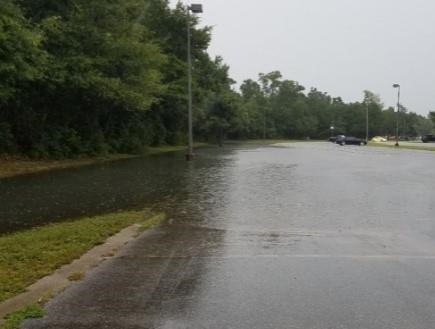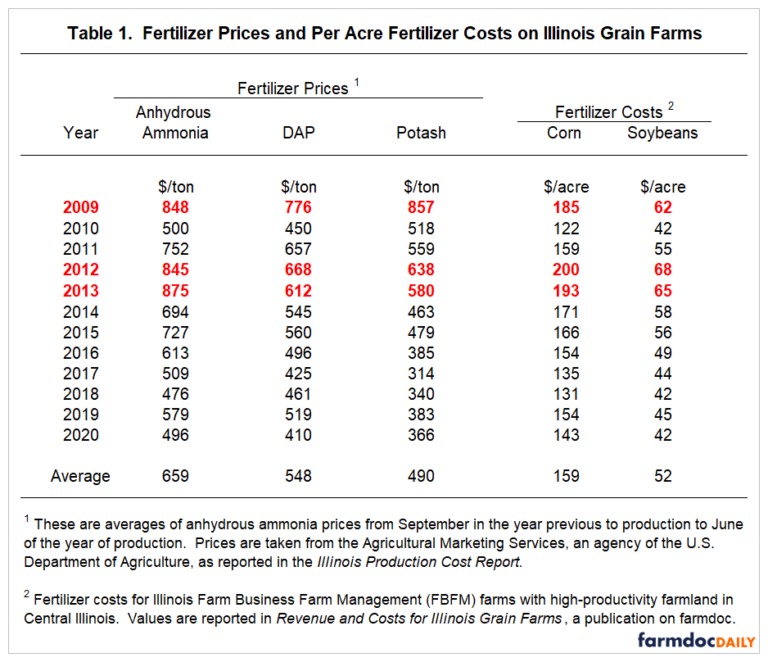By Gary Schnitkey and Nick Paulson et.al
Fertilizer prices have increased dramatically over the past year, with prices on major fertilizer products in Illinois increasing by over 50%. High fertilizer prices lead to projections of near record-high fertilizer costs in 2022 for both corn and soybeans, though short of the all-time high levels set in 2008.
USDA Index Values from 1990 to 2021
The U.S. Department of Agriculture (USDA) regularly calculates index values of prices paid for fertilizers. Figure 1 shows those indices for:
- fertilizers – mixed, hereafter referred to as mixed fertilizers. The mixed fertilizer index is for fertilizers including nitrogen, phosphorus, and potash.
- nitrogen fertilizers. Nitrogen fertilizers primarily are used to supply nitrogen, including anhydrous ammonia, 28% and 32% nitrogen solutions, and urea.
Since the beginning of reporting in 1990, indices exhibited variability, as one would expect with commodities. Both indices began in 1990 with values in the high 20s and then exhibited upward trends through the mid-2000s. From 1990 to 2005, however, several periods of higher prices followed by declines do exist, with more than 10% decline happening in early-2001 and again in 2006 (see Figure 1).
 Many commodities prices, including fertilizers, increased dramatically from mid-2006 until late 2008. Both fertilizer indices hit all-time highs in 2008: mixed fertilizer was 145.9 in October and nitrogen was 135.6 in September (see Figure 1). Rising demand in emerging markets and long-term supply concerns contributed to the record-setting commodity prices. Later in the year, the 2008 financial crisis disrupted all markets, leading to falling commodity prices, including fertilizers.
Many commodities prices, including fertilizers, increased dramatically from mid-2006 until late 2008. Both fertilizer indices hit all-time highs in 2008: mixed fertilizer was 145.9 in October and nitrogen was 135.6 in September (see Figure 1). Rising demand in emerging markets and long-term supply concerns contributed to the record-setting commodity prices. Later in the year, the 2008 financial crisis disrupted all markets, leading to falling commodity prices, including fertilizers.
From 2008 highs, fertilizer indices fell and reached lows in late 2009; 70.1 index value for mixed fertilizers in November and 64.0 value for nitrogen in September. Then, indices rose again and spiked several times. For example, the nitrogen index increased and then declined in late 2011, mid-2012, and mid-2013. From 2013 through 2017, fertilizer prices generally decreased, reaching and maintaining low values through 2020.
Both indices increased in 2021. The mixed fertilizers’ index value was 65.1 in January, reaching 78.4 in June. The nitrogen index increased from 66.7 in January to 85.7 in June. The June values are much higher than year-earlier levels but are not at all-time highs. The last time these indices were at comparable levels was in December 2015. Historical prices suggest that continued price increases through 2021 and 2022 are possible. Of course, declines could occur as well.
Fertilizer Prices in Illinois
Similar trends exist in Illinois as compared to the U.S. Figure 2 shows anhydrous ammonia, diammonium phosphate (DAP), and potash prices in Illinois as reported by the Agricultural Marketing Service (AMS), an agency of USDA. AMS began reporting these prices in September 2008, much later than the reporting for the national indices shown in Figure 1. Over time in which both exist, the series in Figures 1 and 2 track each other closely. For example, the correlation coefficient between the nitrogen index for the U.S. and the anhydrous ammonia price for Illinois is .93.
AMS last reported Illinois fertilizer prices on July 29, 2021, when prices were $746 per ton for anhydrous ammonia, $717 per ton for DAP, and $600 ton for potash. The July 29, 2021 prices were much higher than year-earlier levels on July 30, 2020:
- Anhydrous ammonia increased from $487 per ton in 2020 to $746 per ton in 2021, increasing $259 per ton, or a 53% increase. The last time the anhydrous ammonia price was above $746 per ton was in June 2014.
- DAP increased from $390 per ton to $717 per ton, an increase of $327 per ton, or 83%. The last time prices the DAP prices were above $717 per ton was in December 2008.
- Potash increased from $350 per ton in 2020 to $600 in 2021, increasing $250 per ton, or 71%. The last time the potash price was above $600 per ton was in November 2012.

2021 Fertilizer Costs
Current higher fertilizer prices will translate into higher fertilizer costs for 2022 production of corn and soybeans. However, exact increases depend on farmer behavior and how fertilizer prices change from now through the 2022 fertilizer purchasing season.
Table 1 shows fertilizer prices and per acre costs. Fertilizer prices are averages of those shown in Figure 2, which come from AMS. For each year, the prices shown in Table 1 are the average of prices in September of the year previous to production through June during the year of production. The 2009 fertilizer prices, for example, include prices from September 2008 to June 2009. This period would be the usual purchasing period for fertilizers. Much of DAP and potash are purchased and applied in the fall before planting. Anhydrous ammonia often is applied in the fall as well. Fertilizer applications continue throughout the spring, ending with the application of nitrogen post-planting.

Fertilizer costs shown in Table 1 are for grain farms enrolled in Illinois Farm Business Farm Management (FBFM) and are for high-productivity farms in central Illinois. From 2009 to 2020, fertilizer costs averaged $159 per acre for corn, ranging from a low of $131 per acre in 2018 to a high of $200 per acre in 2012. Soybean costs averaged $52 per acre, with a low of $42 per acre in 2010, 2018, and 2020, reaching a high of $68 per acre in 2012.
Three years, bolded in Table 1, provide more insights into 2022 costs, as these three years have relatively high fertilizer prices:
2009: Fertilizer prices averaged the highest in 2009: $848 for anhydrous ammonia, $776 per ton for DAP, and $857 per ton for potash. In that year, fertilizer costs averaged $185 per acre for corn and $62 per acre for soybeans. In 2009, fertilizer prices declined from highs in fall throughout most of the fertilizer purchasing season. Anhydrous ammonia prices, for example, were at $1,161 per ton in October and below $800 per ton in February 2009 and after. Similarly, DAP and potash prices declined during the purchasing season. The 2009 price declines suggest that 2022 fertilizer costs might be higher than for 2009 if fertilizer prices do not show a similar downward trend in 2021-2022.
2012: Fertilizer prices averaged $845 per ton for anhydrous ammonia, $668 per ton for DAP, and $628 per ton for potash. Fertilizer costs averaged the highest of the 2009-2020 period: $200 per acre for corn and $68 per acre for soybeans. The year 2012 may be close to 2022. Note that the July 29, 2021 prices are close to the 2012 averages:
- Anhydrous ammonia: The $726 current price (July 28, 2021) is below the $845 average for 2012.
- DAP: The $717 current price is above the $668 average for 2012.
- Potash: The $600 current price is below the $628 average for 2012.
2013: In 2013, fertilizer prices were again relatively high: $875 per ton for anhydrous ammonia, $613 per ton for DAP, and $580 per ton for potash. Fertilizer costs averaged the second-highest for the 2009-2020 period: $193 per ton for corn and $65 per ton for soybeans. Note that the July 29, 2021 prices are close to the 2012 averages.
- Anhydrous ammonia: the $726 current price (July 28, 2021) is below the $875 average for 2014.
- DAP: The $717 current price is above the $612 average for 2013.
- Potash: The $600 current price is above the $580 average for 2013.
Overall, current fertilizer price levels point to above-average fertilizer costs for 2022. The 2022 corn and soybean budgets for high-productivity farmland currently have values at $193 per acre for corn and $63 per acre for soybeans, well above the 2009-2020 averages and near the high end of costs for the 2009-2020 period.
Summary
Fertilizer prices currently are at high levels, increasing substantially from year-ago levels, but have not reached all-time highs. Fertilizer prices were the highest in 2008, with those prices then declining during the severe phases of the 2008 financial crisis. Fertilizer costs for 2022 likely will be well above average, with much of the overall cost level depending on fertilizer prices moving forward, as well as farmer behavior. History suggests that fertilizer prices can change rapidly, likely bringing modifications to fertilizer cost projections. Further note that several periods of sharp declines have occurred in history.
Source : illinois.edu